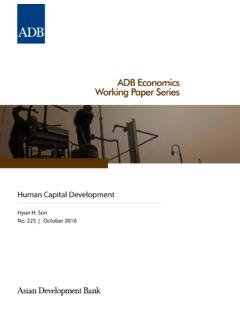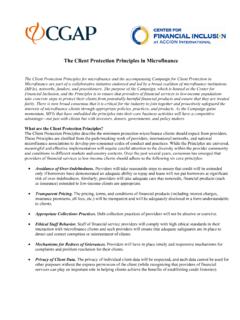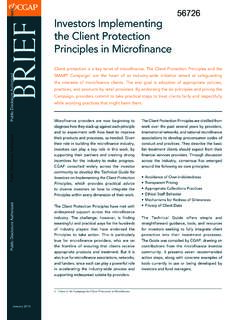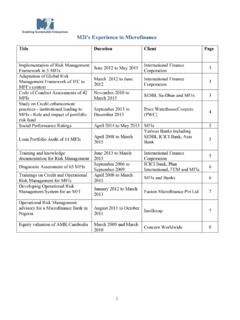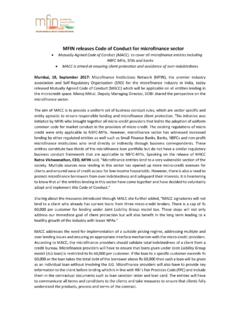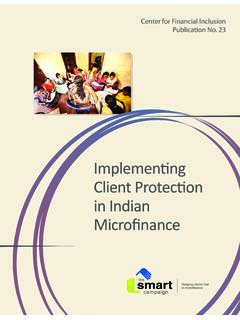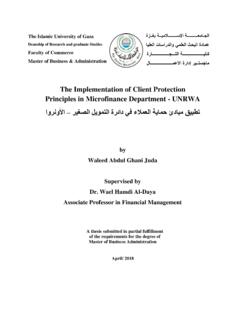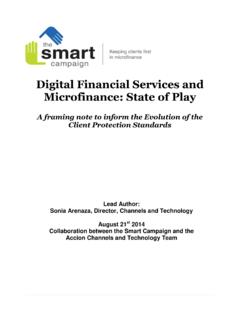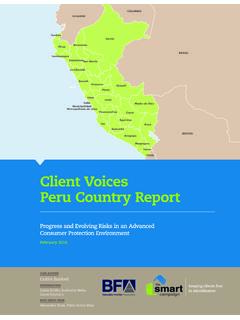Transcription of NO. 74 ADB BRIEFS
1 ADB BRIEFSNO. 74 JANUARY 2017 ISBN 978-92-9257-715-5 (Print)ISBN 978-92-9257-716-2 (e-ISBN) ISSN 2071-7202 (Print)ISSN 2218-2675 (e-ISSN)Publication Stock No. ABF168586-2 DOI: CONSUMER protection AS A CRITICAL POLICY AGENDA ON FINANCIAL INCLUSIONS lower economic growth globally and regulatory tightening in finance has complicated access to finance for vulnerable groups, including low-income households and small businesses. Limited financial access for these groups requires diversified financing modalities accessible to them, addressing the balanced development of banking and nonbank finance industries. microfinance institutions (MFIs), crucially, provide small funds and related services to these groups, helping them to escape poverty and sustain client protection IN ASIA AND THE PACIFIC: LESSONS FROM ADB SMART CAMPAIGN TRAINING PROGRAMSKEY POINTS microfinance institutions must deliver demand-driven and quality services to clients , where financial consumer protection is critical nationally and globally.
2 Differing development stages in microfinance markets in each country require tailored solutions on client protection . Advanced technology both diversifies microfinance services and creates new risks, requiring sophisticated client- protection measures and microfinance education. More focused training is needed nationally and training for trainers should be ShinozakiFinancial Sector Specialist (SME Finance) Sustainable Development and Climate Change Department Asian Development BankAlexandra RizziDeputy Director Smart Campaign GlobalHema BansalDirector Smart Campaign South Asia and South East AsiaTanwi KumariPrincipal Lead Specialist Smart Campaign South Asia and South East AsiaADB BRIEFS NO. 742 The microfinance industry has been growing steadily in Asia and the Pacific, promoting financial inclusion.
3 However, the quality of growth has often been called into question in many countries. This includes issues such as high lending rates, the over-indebtedness of borrowers, and abusive debt collection by financial institutions, undermining poverty reduction and creating financial instability and a more informal finance base. For these reasons, it has become critical to ensure financial consumer protection or microfinance client protection is part of the policy agenda on financial inclusion, nationally and this fact, the Group of Twenty (G20) set up the High-Level Principles on financial consumer protection in 2011, underscoring the importance of advancing financial consumer protection The principles address ten priorities, as indicated in Table 1. The Smart Campaign, launched in October 2009 as an initiative of the Center for Financial Inclusion at ACCION International a New York based not-for-profit corporation is working with microfinance leaders to provide the tools and resources they need to deliver transparent, respectful, and prudent financial services to all clients .
4 The Smart Campaign is taking a leading role in the development and promotion of the client protection Principles in the microfinance industry, which represent a set of core concepts for the treatment of clients . They are operationalized into standards, which are the minimum behaviors from financial institutions that clients should expect. These principles are embedded in the path-breaking work by microfinance service providers, international networks, and national microfinance associations to develop pro-client codes of conduct and practices. The consensus in the microfinance industry is that financial services providers should adhere to the seven core principles in the second column of Table Smart Campaign has developed global knowledge in supporting microfinance networks to help its members implement a code of conduct through training, monitoring systems, and where needed, certification The Smart Campaign and its partners have created and collected a deep body of knowledge and best practice, including over 80 practical tools to support financial institutions in their practices.
5 More than 360 trainings, webinars, and presentations have taken place since 2010, and a cadre of 73 trained assessors and technical consultants has provided tailored support around the PROJECT ON microfinance INDUSTRY S client protection PRINCIPLESIn 2015 2016, the Asian Development Bank (ADB) and the Smart Campaign delivered training programs on the client protection Principles to six of ADB s developing member countries selected from five ADB regions: Azerbaijan, India, the Kyrgyz Republic, Lao People s Democratic Republic (Lao PDR), Myanmar, and Papua New The primary audience for the training was MFI senior management and staff responsible for implementing the code of conduct. Each program targeted around 30 participants from MFIs so that they could enjoy interactive learning The training included the experiential learning 1 OECD.
6 2011. G20 High-level Principles on Financial Consumer From the Smart Campaign, In 2013, the Smart Campaign launched the first ever third-party evaluation of client protection practices in MFIs, with the client protection Certification program. As of November 2016, more than 185 assessments and 100 certification missions had taken place and 72 MFIs been certified, covering more than 35 million TA-8643: Implementation of microfinance Industry s client protection Principles. Training was conducted in (i) Papua New Guinea, Port Moresby, 21 23 October 2015; (ii) India, Mumbai, 2 3 February 2016; (iii) Azerbaijan, Baku, 17 19 February 2016; (iv) Lao PDR, Vientiane, 25 26 February 2016; (v) Myanmar, Yangon on 22 March 2016 and Nay Pyi Taw on 25 March 2016; and (vi) Kyrgyz Republic, Bishkek on 30 March 2016 and Osh on 1 April Number of participants: Azerbaijan 21, India 28, the Kyrgyz Republic 21 (combined two areas), the Lao PDR 30, Myanmar Yangon 112 from 70 institutions, Myanmar Nay Pyi Taw 31, and Papua New Guinea 27.
7 In Myanmar, the country counterpart (Myanmar Micro Finance Association) accommodated strong demand from MFIs for training, providing a large space for that 1: Financial Consumer protection PrinciplesG20 High-Level Principles on Financial Consumer protection , 2011 Smart Campaign s client protection Principles1. Legal, regulatory and supervisory framework2. Role of oversight bodies3. Equitable and fair treatment of consumers 4. Disclosure and transparency5. Financial education and awareness6. Responsible business conduct of financial services providers and authorized agents7. protection of consumer assets against fraud and misuse8. protection of consumer data and privacy9. Complaints handling and redress10. Competition1. Appropriate product design and delivery2. Prevention of over-indebtedness3. Transparency4.
8 Responsible pricing5. Fair and respectful treatment of clients6. Privacy of client data7. Mechanisms for complaint resolutionSources: G20 High-Level Principles on Financial Consumer protection . 2011. OECD; Smart Campaign website ( ). microfinance client protection in Asia and the Pacific3method, such as role plays and group exercises, which helped participants understand client protection issues and develop their own solutions. The training program was well received by all participants as a useful tool to enhance broader and higher-level implementation of the client protection Principles, creating strong demand for continuous training. The six countries selected under the ADB project have all prioritized client protection in their microfinance sectors, albeit in different ways. In Azerbaijan, the central bank has promoted microfinance as a poverty reduction tool, while emphasizing consumer protection as a key foundation.
9 The Reserve Bank of India set up the Fair Practice Code in response to the 2010 Andhra Pradesh microfinance crisis and empowered microfinance industry associations to act as self-regulatory organizations. In the Kyrgyz Republic, the government implemented a mid-term microfinance Development Strategy covering 2011 2015, which included consumer protection . In the Lao PDR, the government has established a taskforce to create a decree on consumer protection to promote sustainable MFI operations. Myanmar enacted the microfinance Law in 2011 and recently passed regulations that encompass the client protection Principles. And in Papua New Guinea, the central bank is responsible for supervising the microfinance industry, with an emphasis on consumer protection , which was supplemented by ADB s microfinance Expansion DEVELOPMENT STAGES OF microfinance MARKETS BY COUNTRYM icrofinance markets in the six countries are at vastly different stages of development, which requires tailored solutions on client protection by each markets can be classified into three development levels, based on four elements: (i) strong microfinance network, (ii) strong operational and managerial capacity of MFIs, (iii) relatively developed microfinance sector in scale, and (iv) regulatory framework on consumer protection .
10 The country accommodating all four elements is a level 1 country, three elements level 2, and one or two elements level 3. Among the six countries, India was categorized level 1, Azerbaijan and the Kyrgyz Republic as level 2, and the Lao PDR, Myanmar, and Papua New Guinea as level 3 (Table 2).High Maturity Market (Level 1)In India, the microfinance industry has gone through boom-and-bust cycles, and client protection is not only a part of regulation, but also embedded in the industry s code of In Andhra Pradesh, poor governance and low credit discipline in the microfinance industry allowed multiple borrowing among households, with high interest rates, and caused the microfinance crisis in 2010. This outcome highlighted the importance of consumer protection . The state government of Andhra Pradesh passed the microfinance Ordinance in 2010 to protect microfinance borrowers from abusive debt collection, and the Reserve Bank of India has promoted the Fair Practice Code nationally.









